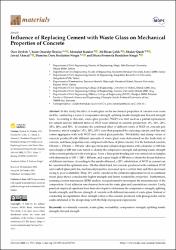Influence of Replacing Cement with Waste Glass on Mechanical Properties of Concrete

View/
Date
2022Author
Zeybek, ÖzerÖzkılıç, Yasin Onuralp
Karalar, Memduh
Çelik, Ali İhsan
Qaidi, Shaker
Ahmad, Jawad
Burduhos-Nergis, Dumitru Doru
Metadata
Show full item recordCitation
Zeybek, Ö.; Özkılıç, Y.O.; Karalar, M.; Çelik, A. ̇I.; Qaidi, S.; Ahmad, J.; Burduhos-Nergis, D.D.; Burduhos-Nergis, D.P. Influence of Replacing Cement with Waste Glass on Mechanical Properties of Concrete. Materials 2022, 15, 7513. https://doi.org/10.3390/ma15217513Abstract
In this study, the effect of waste glass on the mechanical properties of concrete was examined by conducting a series of compressive strength, splitting tensile strength and flexural strength tests. According to this aim, waste glass powder (WGP) was first used as a partial replacement for cement and six different ratios of WGP were utilized in concrete production: 0%, 10%, 20%, 30%, 40%, and 50%. To examine the combined effect of different ratios of WGP on concrete performance, mixed samples (10%, 20%, 30%) were then prepared by replacing cement, and fine and coarse aggregates with both WGP and crashed glass particles. Workability and slump values of concrete produced with different amounts of waste glass were determined on the fresh state of concrete, and these properties were compared with those of plain concrete. For the hardened concrete, 150 mm × 150 mm × 150 mm cubic specimens and cylindrical specimens with a diameter of 100 mm and a height of 200 mm were tested to identify the compressive strength and splitting tensile strength of the concrete produced with waste glass. Next, a three-point bending test was carried out on samples with dimensions of 100 × 100 × 400 mm, and a span length of 300 mm to obtain the flexure behavior of different mixtures. According to the results obtained, a 20% substitution of WGP as cement can be considered the optimum dose. On the other hand, for concrete produced with combined WGP and crashed glass particles, mechanical properties increased up to a certain limit and then decreased owing to poor workability. Thus, 10% can be considered the optimum replacement level, as combined waste glass shows considerably higher strength and better workability properties. Furthermore, scanning electron microscope (SEM) analysis was performed to investigate the microstructure of the composition. Good adhesion was observed between the waste glass and cementitious concrete. Lastly, practical empirical equations have been developed to determine the compressive strength, splitting tensile strength, and flexure strength of concrete with different amounts of waste glass. Instead of conducting an experiment, these strength values of the concrete produced with glass powder can be easily estimated at the design stage with the help of proposed expressions.

















